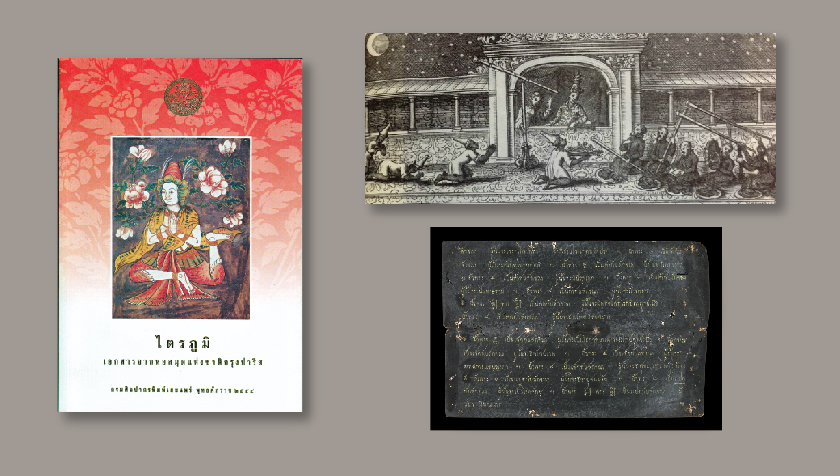
ไตรภูมิฉบับหอสมุดแห่งชาติกรุงปารีส: การศึกษาเปรียบเทียบระหว่างเรื่อง มหาพรหมเทพราชทอดเลขกับตำนานของศาสนาพราหมณ์-ฮินดู
The National Library of Paris’s Version of Tribhum: A Comparative Study of Mahabrama Devaraj Tord-Lek with Brahmanism-Hinduism Mythology
โดย ภัครพล แสงเงิน / By Phakphon Sangngern
Damrong Journal, Vol 15, No.1, 2016
บทคัดย่อ:
บทความนี้มุ่งศึกษาเปรียบเทียบระหว่างเรื่องมหาพรหมเทพราชทอดเลขในไตรภูมิฉบับหอสมุดแห่งชาติกรุงปารีสกับตำนานของศาสนาพราหมณ์-ฮินดู ผลการศึกษาพบ 2 ประเด็นคือ 1) เรื่องมหาพรหม เทพราชทอดเลขซึ่งว่าด้วยเทวดาทั้ง 12 พระองค์นั้น มีความเกี่ยวข้องกับตำนานของศาสนาพราหมณ์-ฮินดู ซึ่งเนื้อหาส่วนใหญ่มีความคล้ายคลึงกันแต่ต่างกันที่รายละเอียดปลีกย่อย 2) เรื่องมหาพรหมเทพราชทอดเลขนี้น่าจะสัมพันธ์กับคติเรื่องพระพรหมสร้างโลกในศาสนาพราหมณ์-ฮินดู อีกทั้งเรื่องมหาพรหมเทพราชทอดเลขนี้น่าจะเป็นเรื่องทางโหราศาสตร์ของไทยซึ่งได้รับอิทธิพลสำคัญมาจากศาสนาพราหมณ์-ฮินดู สรุปได้ว่า ไตรภูมิฉบับหอสมุดแห่งชาติกรุงปารีสเป็นไตรภูมิสมัยอยุธยาที่แสดงให้เห็นถึงความเกี่ยวข้องกับตำนานของศาสนาพราหมณ์-ฮินดูซึ่งเป็นแนวคิดหลักที่ปรากฏในสังคมและวัฒนธรรมของสมัยอยุธยาอย่างชัดเจน
ABSTRACT:
The purpose of this article is to conduct a comparative study of Mahabrahma Devaraj Tord-Lek (which literally means “Mahabrahma Devaraj cast the twelve numbers into the air”) with Brahmanism-Hinduism Mythology. As a result, the study proposes two findings. 1) Mahabrahma Devaraj Tord-Lek, the story which relates how the twelve deities come into existence, may be traced back to Brahmanism-Hinduism Mythology. 2) It is comparable to the creation myth in Brahmanism-Hinduism. The story of Mahabrahma Devaraj arguably demonstrates the influence of Brahmanism-Hinduism on Siamese astrology. In conclusion, the National Library of Paris’s Version of Tribhum was written in the Ayutthaya Period, showing the influence of Brahmanism-Hinduism on the contemporary worldview.











